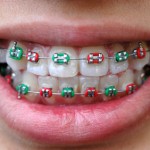
Fixed appliance orthodontic treatment increases the potential number of sites on teeth that favour plaque formation and biofilm growth. The presence of orthodontic appliance elements also reduces the efficiency of oral hygiene measures. Studies have suggested that different orthodontic ligation methods have different effects on biofilms and species of microorganisms.
The aim of this review is to compare elastomeric ligation with self-ligation and steel wire ligation with regard to clinical outcomes and microbiological measures of biofilm formation.
Methods
Searches were conducted in the Medline/PubMed and Embase databases with no limits on date or language. Two reviewers screened and selected studies and extracted data. The revised Cochrane Collaborations tool (RoB 2.0) was used to assess risk of bias. Parallel-group and split-mouth randomized controlled trials (RCTs) comparing different orthodontic ligation methods were considered. Owing to study heterogeneity a narrative summary was undertaken.
Results
- 11 RCTs (8 split-mouth, 3 parallel) involving a total of 196 patients were included.
- 7 studies were considered to be at high risk of bias and 4 has some concerns.
- 6 RCTs provided clinical outcomes and 9 studies microbiological outcomes.
- 9 studies compared elastomeric ligation with self-ligation
- 5 studies examined plaque scores, 3 reported no significant difference and 2 found a small statistically significant differences.
- 3 studies reported gingival scores 2 reported no difference 1 found that passive self-ligation performed significantly better
- 3 studies reported bleeding scores 2 reporting no difference and one showing a statistically significant benefit for passive self-ligation
- 1 study reported on probing depth finding no difference.
- 2 studies compared elastomeric ligation with steel ligation finding that steel ligation performed significantly better for plaque index, gingival bleeding index and probing depth
Conclusions
The authors concluded: –
There were no significant differences between self-ligation and elastomeric ligation for biofilm formation in patients wearing multi-bracketed fixed orthodontic appliances. Stainless steel ligation may accumulate less biofilm than elastomeric ligation; however, the clinical significance of the difference could not be evaluated. Further high-quality studies are required in order to determine which ligation method is better for managing biofilm formation in patients wearing multi-bracketed fixed orthodontic appliances.
Comments
We have previously considered one of the earlier reviews on this topic by Arnold et al (Dental Elf – 29th Mar 2017) mentioned by the authors of this recent review. The reviewers registered their review on PROSPERO and searched two major databases although the Cochrane CENTRAL database would have been a useful addition as its focus is RCTs. While 11 RCTs were included they are small, and the majority were considered to be at high risk of bias. The maintenance of effective oral hygiene measures during orthodontic treatment to prevent adverse outcome such as caries or periodontal disease is important. However, the impact of different elements of the orthodontic appliance may or may not be clinically important as long as oral hygiene measure are effective. In order to have better information to address this question larger well conducted and reported studies using common outcomes sets would be needed.
Links
Primary Paper
Skilbeck MG, Mei L, Mohammed H, Cannon RD, Farella M. The effect of ligation methods on biofilm formation in patients undergoing multi-bracketed fixed orthodontic therapy – A systematic review. Orthod Craniofac Res. 2021 May 27. doi: 10.1111/ocr.12503. Epub ahead of print. PMID: 34042260.
Other references
Dental Elf – 29th Mar 2017
Self-ligating brackets: Brace yourself! It’s time for some spring cleaning!
Dental Elf – 22nd Jul 2016
